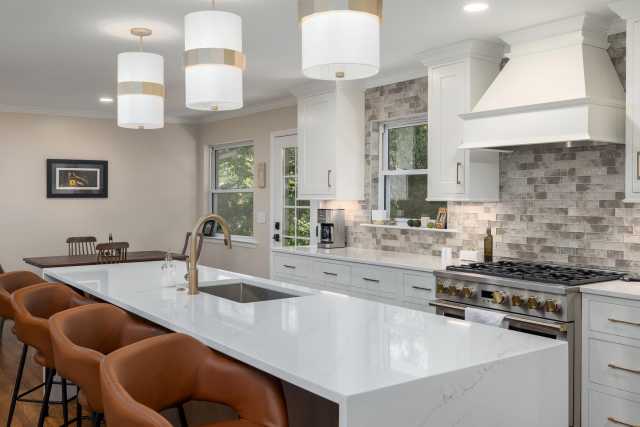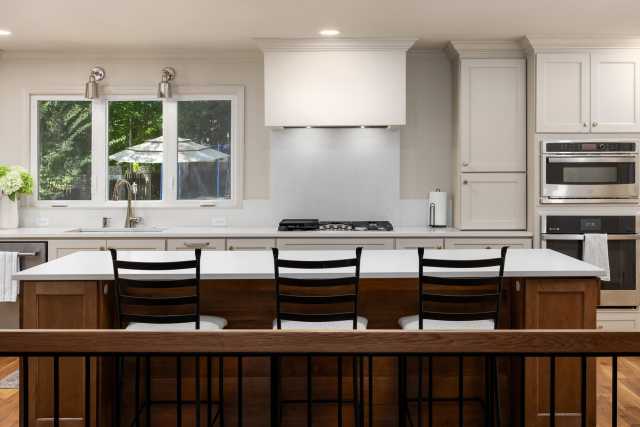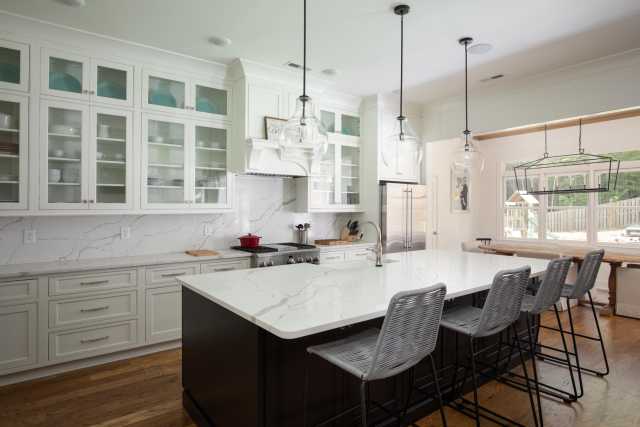The 2025 Custom Home: An In-Depth Analysis of Architectural, Technological, and Lifestyle Trends - part 5

Economic and Market Context - Navigating the Realities of Building in 2025
The trends shaping the 2025 custom home—from sustainable technologies to innovative architectural forms—do not exist in a theoretical vacuum. Their adoption and expression are profoundly influenced by the practical realities of the economic and market landscape. Macroeconomic forces such as interest rates and labor availability, the dynamics of the remodeling versus new construction markets, and the distinct cultural and climatic characteristics of different regions all play a crucial role in determining what gets built, how it gets built, and for whom. This section grounds the preceding analysis in these real-world contexts to provide a complete picture of the custom home building industry in 2025.
The Economic Landscape: Interest Rates, Material Costs, and Labor Shortages
The decision to embark on a custom home project in 2025 is made against a backdrop of a complex and evolving economic climate. While the market shows signs of stability, builders and clients must navigate several persistent challenges that impact project budgets, timelines, and overall feasibility.
According to the latest economic outlook from the National Association of Home Builders (NAHB), the U.S. economy is experiencing a period of slowing but not stalling growth, with GDP forecasts for 2025 hovering around 1%, down from nearly 3% in 2023. While there remains a roughly 30% chance of a recession, positive job growth and low unemployment provide a measure of stability. A key factor influencing the housing market is interest rates. The Federal Reserve began a cycle of rate cuts in late 2024, offering some relief after a period of steep hikes. However, industry analysts do not expect mortgage rates to fall below the 6% threshold in the near future. On a more positive note for builders, interest rates on acquisition, development, and construction (AD&C) loans saw a slight decrease in the first quarter of 2025, which could help improve the financial feasibility of new projects. Builder confidence, as measured by the NAHB/Wells Fargo Housing Market Index (HMI), has been soft but is stabilizing. Forecasts call for a modest improvement in housing starts, with projections showing a flat market in 2025 followed by a gradual increase of 2% to 5% annually through 2027. Despite these signs of stabilization, the industry continues to grapple with several significant and persistent challenges. In surveys, builders consistently cite the following as the most prominent issues they face in 2025: the high cost and limited availability of developed land; persistent shortages of skilled labor across key trades; and elevated costs for building materials and insurance. These economic headwinds are not merely obstacles; they are powerful catalysts. The high costs and unpredictability associated with traditional construction methods are actively pushing the industry to embrace the very trends detailed in this report. High-performance systems like geothermal and solar offer a clear ROI by reducing long-term operating costs, providing a hedge against volatile energy prices. Innovative construction methods like mass timber and 3D printing promise faster build times and reduced on-site labor, directly addressing the industry's core efficiency challenges. Therefore, the economic pressures of 2025 are acting as a forcing function, making the business case for a more sustainable, high-performance, and technologically advanced approach to home building more compelling than ever.
The Remodeling Boom: Key Drivers and Opportunities for Renovation vs. New Build
The custom home building industry is not solely defined by new construction; a vibrant and growing segment of the market is dedicated to high-end remodeling and renovation. In 2025, this sector is particularly robust, driven by a unique confluence of economic and demographic factors. The NAHB forecasts that the residential remodeling market will post a strong 5% gain in 2025, followed by another 3% in 2026, indicating sustained and healthy demand. Several key drivers are fueling this boom. A primary factor is the aging housing stock in the United States; a large percentage of existing homes are now several decades old and in need of significant updates to meet modern standards of style, functionality, and performance. Compounding this is the economic reality of the "rate lock-in" effect. Many current homeowners are holding mortgages with historically low interest rates, making them reluctant to sell their homes and take on a new mortgage at a much higher rate. This disincentivizes moving and instead encourages them to invest in their current properties. This is made possible by the record levels of home equity that many homeowners have accumulated, providing them with the financial means to undertake substantial renovation projects. A major demographic driver is the aging-in-place movement. As the baby boomer generation ages, there is a massive demand for renovations that adapt homes for long-term accessibility and safety. An NAHB survey revealed that an overwhelming 98% of remodelers report that their customers are familiar with the aging-in-place concept, a significant increase from 75% two decades ago, highlighting the growth of this market segment. The trends seen in high-end remodeling closely mirror those in new custom construction. Homeowners are renovating to create the very features detailed in this report: open-concept living spaces with better indoor-outdoor flow, sophisticated kitchen complexes with sculleries, and spa-like bathroom retreats. They are upgrading to high-performance systems like geothermal and solar and integrating smart home technology. A related trend is adaptive reuse, where homeowners and builders convert non-residential structures like old barns, warehouses, or historic buildings into unique and character-rich modern homes, blending heritage with contemporary design and sustainable principles. This thriving remodeling market represents a parallel and vital track for the custom building industry, applying the same principles of modern luxury to the existing housing stock.
Regional Variations: How Climate and Culture Shape Custom Home Trends Across the U.S.
While the macro trends of sustainability, wellness, and technology are national in scope, their architectural expression is highly regional. The "one-size-fits-all" modern box is being replaced by a new, more nuanced regionalism, where custom home design is deeply rooted in the specific climate, culture, and landscape of its location. This is driven by the practical demands of climate resilience and a cultural desire for authenticity that favors local materials and vernacular styles.
- Palm Beach, Florida & Coastal Southeast: In this tropical, waterfront environment, design is dictated by the climate and the view. Architecture often draws inspiration from historic styles like Spanish Mediterranean, featuring stucco exteriors and terracotta roofs, but updated with clean, contemporary interiors. The primary focus is on maximizing ocean and Intracoastal views with floor-to-ceiling, impact-resistant glass walls and creating elevated outdoor living spaces—such as resort-style cabanas, loggias, and sophisticated outdoor kitchens—that can be enjoyed year-round.
- Denver Metro & Mountain West: Here, the rugged landscape inspires a style often called "Mountain Modern." This aesthetic is characterized by angular silhouettes with sharp, dramatic rooflines, and a rich palette of mixed materials including reclaimed wood, natural stone, and steel. Expansive glass walls are essential for capturing panoramic mountain views. In a region prone to wildfires, there is also a strong emphasis on resilient design, using fire-resistant materials like fiber cement or metal siding and incorporating mass timber for its structural and fire-retardant properties.
- The Southwest: The desert environment gives rise to a distinct "Organic Desert" or modern adobe style. Exteriors feature stucco or adobe-inspired finishes in warm, earthy tones of sand, clay, and ochre. Architectural elements include soft, rounded archways, built-in niches (nichos), and textured plaster walls. Interiors often have terracotta tile floors, exposed wood beams (vigas), and handcrafted tilework. A central design principle is the creation of shaded courtyards and the use of xeriscaping with native, drought-tolerant plants to conserve water.
- The Pacific Northwest: This region's identity is closely tied to its lush forests and progressive environmental values. This is reflected in a strong emphasis on biophilic design and the pioneering use of sustainable materials, most notably mass timber. The architectural style often features large overhangs for protection from rain, natural wood siding, and designs that deeply integrate the home into its forested surroundings.
- The Midwest: The Modern Farmhouse continues to be the dominant and time-honored style, resonating with the region's agricultural heritage and landscape. The style's emphasis on practicality, large inviting porches, and simple, clean lines feels deeply rooted in the Midwestern ethos. In lake regions, there is also a focus on creating family compounds with auxiliary structures like boathouses and bunkhouses to support a lifestyle centered on seasonal, outdoor recreation.
This resurgence of regionalism is a direct outcome of the core philosophies of 2025. A truly sustainable home uses locally sourced materials and is designed for its specific climate. A home focused on wellness is one that connects its occupants to their natural surroundings. And an authentic home is one that reflects the character and history of its place. Together, these forces are creating a richer, more diverse, and more meaningful American architectural landscape.
Conclusion & Strategic Recommendations
The landscape of custom home building in 2025 is defined by a sophisticated convergence of ideals and innovations. The analysis reveals a clear departure from transient trends toward the adoption of enduring principles that holistically enhance the quality of life. The modern luxury home is no longer just a product of its aesthetic but a high-performance ecosystem engineered for sustainability, wellness, and seamless technological integration. It is a sanctuary that nurtures its occupants, a resilient structure that respects its environment, and an authentic expression of personal values.
The core philosophies of Eco-Luxury and the Wellness Mandate are now inextricably linked. The pursuit of a healthy indoor environment—with pristine air and water, and circadian lighting that supports natural rhythms—necessitates high-performance systems. The responsible operation of these systems, in turn, drives the adoption of on-site renewable energy like solar and geothermal, making the business case for Net-Zero performance increasingly rational. This synergy demonstrates that in 2025, a truly "well" home is, by definition, a sustainable one.
Architecturally, the static, compartmentalized home has been replaced by a dynamic and fluid environment. The dissolution of indoor-outdoor boundaries and the rise of adaptable, multi-functional spaces are not merely stylistic choices but direct responses to a modern lifestyle that demands flexibility for work, family, and retreat. The evolution of the kitchen into a "multifunctional complex" and the bathroom into a "private spa" further underscores this focus on creating spaces that are both highly functional and deeply restorative.
This is all underpinned by a technological and material revolution. Human-centric smart home technology is becoming invisible and anticipatory, serving occupants without demanding their attention. Simultaneously, this increasing automation is fueling a powerful desire for authenticity and craft, elevating natural, tactile, and even imperfect materials over their synthetic counterparts. Emerging construction methods like mass timber and 3D concrete printing, while still in early adoption for single-family homes, signal a fundamental industry shift toward prefabrication and automation, promising to address long-standing challenges of cost, speed, and labor.
Strategic Recommendations for Stakeholders:
- For Prospective Homeowners: Prioritize the integration of the "new trinity" of value: sustainability, wellness, and human-centric technology. Approach these not as separate line items but as an interconnected system. When making significant financial decisions, focus on the long-term return on investment (ROI) and total cost of ownership for systems like geothermal and solar, factoring in energy savings, tax incentives, and increased resale value. Embrace deep personalization and invest in authentic, high-quality materials and craftsmanship that will provide enduring satisfaction beyond fleeting trends.
- For Architects and Designers: Lead the conversation with clients away from features and toward the underlying philosophies of living. Frame sustainability and wellness not as constraints but as powerful drivers of innovative and luxurious design. Develop expertise in the technical integration of high-performance systems and be prepared to guide clients through the complex cost-benefit analysis. Champion regionalism by exploring local materials and vernacular styles to create homes that are uniquely of their place.
- For Custom Builders and Developers: Invest in training and expertise for high-performance building envelopes and the installation of advanced systems like geothermal, solar with battery storage, and smart home automation platforms. These are no longer niche specialties but core competencies for the luxury market. Begin exploring innovative construction methods like mass timber and 3DCP through pilot projects or partnerships to stay ahead of the curve. The economic headwinds of 2025 are an opportunity to differentiate your business by offering solutions that provide greater efficiency, predictability, and long-term value to clients.
Ultimately, the most successful custom homes of 2025 and beyond will be those that look past the surface of trends to embrace the fundamental principles of creating healthier, more resilient, and more meaningful places to live.





